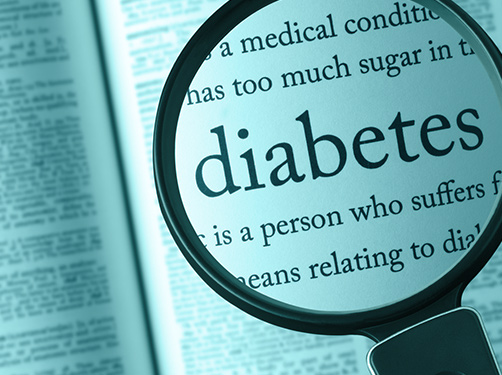How is gestational diabetes treated?
Scientific support: PD Dr. Sandra Hummel
Gestational diabetes slightly increases the risk of certain birth complications. Usually just a change in diet and exercise, tailored to pregnancy, will be able to reduce the risk and sufficiently lower blood glucose. Dietary advice may be helpful here. This ensures that the diet contains everything the mother and child need. A balanced diet and exercise also help to prevent excess weight gain or overweight during pregnancy.

Regular blood glucose monitoring helps check if the glucose values are returning to normal. Pregnant women should learn how to measure their own blood glucose. Only about 1 in 4 patients require treatment with insulin. Recently a tablet that lowers blood glucose during pregnancy has been officially approved. The vast majority of women with gestational diabetes have an otherwise normal pregnancy and give birth to a healthy child.
Treatment of gestational diabetes should be arranged in consultation with the doctor treating the patient. If necessary, a referral to a diabetes specialist (diabetologist) may be a sensible option to determine further treatment. This ensures that the risks for mother and child are minimized.
In most women, blood glucose levels return to normal after the child is born. Women with gestational diabetes do, however, have a higher risk of developing type 2 diabetes later on. This is why follow-up care with glucose tolerance tests is so important.
What are the target blood glucose levels for gestational diabetes?
The following target blood glucose levels apply for gestational diabetes:
- Fasting blood glucose after getting up should be below 95 mg/dl (5.3 mmol/l).
- 1 hour after starting a meal, levels must not rise above 140 mg/dl (7.8 mmol/l).
- 2 hours after starting a meal, levels must not rise above 120 mg/dl (6.7 mmol/l).
Treatment goals should not, however, be as rigid as the values listed above. They have to be adjusted to each individual depending on the circumstances of the pregnancy. Only when the specified target values are over the limits in more than half of the readings is treatment with insulin required.
Why is it important to regularly measure blood glucose?
A good adjustment of the blood glucose level in pregnancy requires the patient to regularly check their blood glucose. It is helpful to record the measured values in a suitable diary.
Pregnant women are shown how to measure their blood glucose. A small lancet is used to draw blood from the fingertip and apply it to a test strip. The monitoring device shows the blood glucose level after a short time.
The pregnant woman should measure 4 times a day for 1 to 2 weeks after diagnosis (4-point profile):
- Fasting before breakfast and
- respectively 1 and 2 hours after the start of each of the 3 main meals (breakfast, lunch and dinner).
This gives a daily profile of the blood glucose levels. If all values are within the target range within the first 2 weeks, 2 daily profiles per week are sufficient. Alternatively, you can reduce the number of measurements to 1 a day. We recommend measuring alternately - fasting and after the main meals.
What is an ideal diet for gestational diabetes?
With gestational diabetes, the pregnant woman should first check her diet. In about 70 to 80 percent of cases, simply changing diet is enough to achieve good blood glucose levels. It is best to consult an expert for nutrition or diabetes advice. They will adjust the menu to your pregnancy and diabetic metabolism based on your personal habits.
Nutrition during gestational diabetes is not a diet, but rather balanced and nutritious food. The recommendations are based on healthy nutrition during pregnancy. What is important is that mother and child receive all important nutrients.
As a basic principle, it is important to avoid a high and rapid increase in blood glucose after eating. You should note the following:
- Split your meals into 3 main meals and 3 snacks. This helps you achieve steady blood glucose levels over the course of the day. As the rise in blood glucose is highest in the mornings, eat fewer carbohydrates for breakfast than at lunch or dinner.
- If your blood glucose levels are high in the morning, do not eat any food or drink for breakfast that contain sugar. For instance, opt for wholegrain bread with cheese or muesli made of cereal flakes with yogurt or soft cheese. Fruit juice, jam or honey are not suitable in this case.
- Eat high fiber foods such as wholegrain products, pulses, vegetables, salad or fruit. These are more slowly digested because of their high fiber content. This delays the release of carbohydrates into the blood. White bread and other low fiber cereal products, in contrast, result in a rapid increase in blood glucose. Try to avoid these foods.
- Eat plenty of vegetables and salad and only a moderate amount of fruit. Limit your fruit intake to 2x 150 gram portions. Very sweet fruit such as bananas or grapes are less suitable.
Good to know:
Despite changing diet it is important to ensure the unborn child has sufficient nutrients.
- Only eat a small amount of food containing sugar. Sugar in drinks quickly enters the bloodstream where it results in a fast and sharp rise in blood glucose. Therefore avoid soft drinks, iced tea or fruit juice. It is better to drink plenty of water or unsweetened tea. Confectionery such as chocolate, cookies or cake contain a relatively high proportion of fat alongside sugar.
A balanced diet and exercise – even a 30-minute brisk walk helps – also help reduce excess weight in pregnancy. There is no uniform figure stating how much weight gain is normal or permitted in pregnancy. This is based on the woman’s weight before pregnancy and varies from one woman to another. The attending doctor monitors the woman’s weight.
When is treatment with insulin required?
If blood glucose levels cannot be adequately reduced by a change in lifestyle, an insulin treatment is introduced. About 1 in 4 women with gestational diabetes have to inject insulin.
Insulin is a hormone produced by the body that lowers blood glucose. Administration of insulin as a drug is harmless to the child as it does not cross into the uterus. And the child also benefits if the mother’s blood glucose is well-managed. His or her glucose exposure falls.
There are various insulin preparations available for pregnant women for insulin treatment. With an intensive insulin therapy the pregnant women injects a long-acting insulin once or twice a day (in the morning and/or evening) to cover her basic insulin requirements. Rapid-acting insulin supplements requirements around mealtimes.
Even if treated with insulin, the pregnant woman should keep an eye on her diet so that the insulin requirements are not too high. The insulin dose should be adjusted up to birth as the requirements change. The gynecologist regularly monitors the child’s growth in the womb with an ultrasound. The gestational diabetes is treated until the child is born. Then in most cases the mother’s blood glucose normalizes and no longer requires insulin. For the mother it is important, however, to keep an eye on her blood glucose.
Why is follow-up care after the birth so important for gestational diabetes?
In most women, blood glucose values return to normal after pregnancy. However, women who have gestational diabetes have a higher risk of type 2 diabetes after pregnancy. All women who have normal blood glucose levels after giving birth should have a 75-g glucose tolerance test 6 to 12 weeks after the birth. In annual diabetes tests, the doctor generally measures fasting blood glucose and the long-term blood glucose value HbA1c. It can also be useful to repeat the 75-g glucose test, e.g. every 2 years.
Click here for more information on the glucose tolerance test.
Further information on gestational diabetes
Sources:
Deutsche Diabetes Gesellschaft et al.: S3-Leilinie Gestationsdiabetes mellitus (GDM) - Diagnostik, Therapie und Nachsorge. Langfassung. 2. Auflage. 2018
Deutsche Diabetes Gesellschaft et al.: S3-Leilinie Gestationsdiabetes mellitus (GDM) - Diagnostik, Therapie und Nachsorge. Patientinnenempfehlung. 2. Auflage. 2018
Kleinwechter, H. et al.: Gestationsdiabetes mellitus (GDM) – Diagnostik, Therapie und Nachsorge. In: Diabetologie, 2017, 12: S218-S232
Klinikum rechts der Isar der Technischen Universität München: Gestationsdiabetes (GDM). 2017 (Letzter Abruf: 11.10.2019)
As of: 25.01.2021





